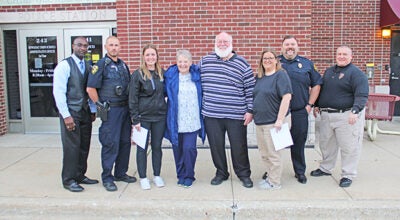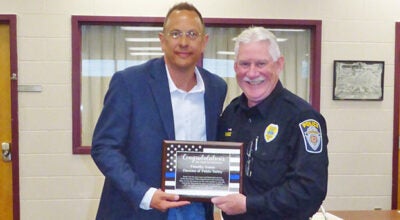Students step out of classroom and into a crime scene
Published 4:21 pm Thursday, June 17, 2010

Kiara Prater of Cassopolis and Harley Budd of Dowagiac analyze powders. At a real crime scene, investigators would proceed cautiously until they knew if a substance was crack cocaine or unrelated flour from baking a cake. (Vigilant photo/JOHN EBY)
By JOHN EBY
Cassopolis Vigilant
DOWAGIAC – For 16 middle schoolers from around Cass County – 11 girls to five boys, perhaps thanks to TV’s “Bones” about a forensic anthropologist – they don’t seem to mind spending summer vacation nights doing homework.
That’s because their days this week of 30-hour Crime Scene Investigation (CSI) Junior Academy at Southwestern Michigan College are filled with watching blood drops spatter in slow motion usually reserved for sports replays, collecting trace evidence such as hair and fiber with tweezers while wearing rubber gloves, analyzing soil and powders, making impressions of their feet, teeth and tire tracks and cataloguing skeletal remains in Educational Talent Search’s Amy Anderson’s “dungeon,” the table storage closet of Mathews Conference Center.
Thanks to the Internet, they watch the difference angle makes in a drop of blood spattering, from 90 to 25 degrees.
“I took some forensics classes in college,” Anderson said. “I get into it. They watch ‘Bones,’ so I watched a couple of episodes.”
The class combines lecture, discussion and hands-on participatory exercises presented in an informal, relaxed atmosphere.
These disparate threads will knit themselves together as the week goes on leading up to a mock trial Friday at the Cass County Law and Courts Building before a real prosecutor, defense attorney and judge.
Participants include: James Kusa, Caitlyn Napier, Harley Budd, Nicole Irwin and Justin McCambridge, Dowagiac; Sabrina Baird and Jack Kison, Marcellus; Tyler Ward, Monica Ward, Abigail Harrison, Kiara Prater, Jacob Allison and Jaleesa Warner, Cassopolis; and Becky Haines, Alexis Tidey and Cecilia Winchester, Edwardsburg.
Tuesday afternoon Officer Jim Kusa of Dowagiac Police Department instructed junior detectives in collecting blood evidence with a sterile cotton swab – a long-handled Q-tip.
If the blood’s wet, roll it through the stain and air dry, or it will mold in a plastic evidence bag. If it’s dry, add distilled water.
Tap water’s chemicals could damage DNA.
Kusa told them about AFIS, the Automated Fingerprint Identification System, to which he adds another nationwide database, CODIS, for identifying DNA.
“If you’re arrested for a felony it’s mandatory that we take a swab” from cells inside the cheek to send to the state for entry into the database.
“DNA is extracted and compared with other DNA profiles in the CODIS database and if they match, that’s how we get our suspect. If we have a known suspect, we do the same thing,” Kusa explains. “We’ll get a search warrant for the cells from his mouth. Both of those samples go to the crime lab for confirmation.”
“If we’ve got blood all over the place,” Kusa continues, “we want to take samples from different areas. Not just one area. If there’s a lot of blood spatter against the wall that looks the point of origin, you might want to take from that area. If it looks like somebody staggered and fell down, you might want to collect a sample from that area. Cross-contamination of blood – in self-defense, our suspect may have gotten injured and bled himself. We might want to take blood walking away from the scene which might be from the suspect. It could be the victim’s blood on a suspect if he’s walking away with a bloody knife.”
Det. Phil Small of the Cass County Sheriff’s Office addresses trace evidence.
“I did a B&E – breaking and entering – where the guy was wearing gloves,” he said.
No fingerprints, but the bad guy wore a bandanna.
“It fell off and I got some hair off it,” Small relates. “Or, if they’re drinking a pop and they leave their can behind. Where it came into contact with the mouth” can be swabbed for DNA. “Maybe they smoked out behind the crime scene” and flicked away a cigarette butt that can be bagged with tweezers.
Besides the DPD and the Sheriff’s Office, Pokagon Band Tribal Police supports the academy.
Officer MaKenzie Jahr will play a victim today, while Small will portray a suspect.
Kusa also acquainted detectives with the proper way to photograph a crime scene: “Start on the outside, the perimeter, and shoot pictures all the way around, then move in and concentrate on your evidence. Photograph it from a distance away, then close in on it,” putting a ruler next to an object to verify its size in court.
Today they will use these new skills to process three crime scenes in teams of five, five and six. Thursday they interview a medical examiner.
High schoolers next week will attend the second annual fire academy, which will roam away from the SMC campus after two days of classwork with Capt. Mike Mattix of the Dowagiac Fire Department into town for smoky search and rescue exercises.
Three crews will extinguish vehicle fires with back-up from real area firefighters, then investigate.
The finale, after learning how to operate firetruck hoses, climbing the 75-foot ladder and playing water soccer, is a visit to Chicago’s fire academy after an overnight campout at the city fire station.
Students and firefighters will take turns preparing each other a meal.
“For fire,” she said, “we have 16 registered – five boys and 11 girls, and that’s high school. That threw me. I think girls are more outgoing and involved in trying out new things. You have to really sell guys on it.”
Anderson’s agenda doesn’t let up any time soon.
The following week is a tour of four Upper Peninsula colleges.
School of Rock for high schoolers takes place at Western Michigan University July 12-15.
Participants cut their own CDs.
Middle schoolers can participate in the Weird Science camp, which takes them to Fernwood near Niles and to Chicago’s Shedd Aquarium for marine biology July 26-29 .
Aug. 9-13 offers art and design to high schoolers, with one day at SMC, then Chicago for exposure to photography and architecture.
“Our newest one, Aug. 23-26, is Spy Camp,” Jahr said.
SMC’s ETS program identifies and assists individuals with potential to succeed in higher education.
The program provides academic, career and financial counseling to participants and encourages them to graduate from high school and continue on to the post-secondary institution of their choice.
ETS serves 800 students in grades 6-12 from the Brandywine, Cassopolis, Dowagiac, Edwardsburg and Marcellus school districts.
SMC received federal grants last September of $259,574 to support the program for the 2009-2010 school year.






